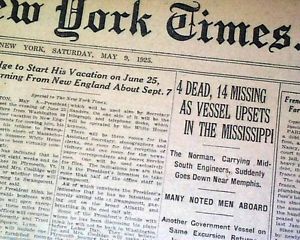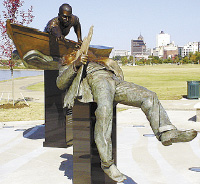|
Help About Related Share Your Story General Mall
Food Court Retail Entertainment Management Souvenirs Related Links
|
TomLee
Tom LeeOctober 22. 2013 Some events happened so long ago that it seems there can't be any possible link to the present. But this week, the last known survivor of the sinking near Memphis of the steamboat M.E. Norman — a tragedy that made rescuer Tom Lee a national hero — died in Memphis. Leroy Hidinger Jr. was 93. Memphis Magazine Some events happened so long ago that it seems there can't be any possible link to the present. But this week, the last known survivor of the sinking near Memphis of the steamboat M.E. Norman — a tragedy that made rescuer Tom Lee a national hero — died in Memphis. Leroy Hidinger Jr. was 93. Memphis Magazine In 1925, race was a BIG issue in Memphis. Some people think the times haven't changed since then but in truth, those people are slowly fading away. Three generation later, it's hard to envision how awful it was - white or black, today - we have NO idea how terrible it would have felt. Slavery had been abolished legally 60 years earlier in 1865 by the 13th amendment to the United States Constitution: Amendment XIII: Section 1. Neither slavery nor involuntary servitude, except as a punishment for crime whereof the party shall have been duly convicted, shall exist within the United States, or any place subject to their jurisdiction. Section 2. Congress shall have power to enforce this article by appropriate legislation. Still, it is appropriate that todays Memphis remember that times were different. Black people were legally free, but still treated badly, unfairly and harshly by most. They were forced to use different doors to public places, different water fountains, different bathrooms, etc. Segregation. It made sense to the people of the day but now seems like nonsense. In that context, it's easy to understand that a black man in Memphis in 1925 might not be inclined to go out of his way for white people of the day. But humanity knows no color - and just as some whites of the era treated blacks as people, not colors, Tom Lee, a black man, treated whites as people, not colors - his humanity saw past the racism of the time. Humanity And A Worthy Negro
Tom Lee was a levee worker steering upstream on the Mississippi River in a 28-foot skiff (wooden motor boat) named "Zev" after delivering an official to Helena, AR. He witnessed the U.S. Army Corps of Engineers steamer M.E. Norman capsize and sink just south of Memphis at Cow Island Bend. The Norman carried members of the Engineers Club of Memphis, the American Society of Civil Engineers and their families who were in Memphis for the Mid-South Society of Civil Engineers convention.  He turned his boat upstream toward the sinking ship and when he reached it, he risked his own life to to pull 32 people out of the Mississippi River even though he did not know how to swim. All of the people rescued where white. He ferried five boatloads of men, women and children to shore, burying some in the sand for warmth. Though 23 people died that evening, 32 survived. The date was May 8, 1925, and Lee was honored as the first black hero in the history of Memphis.  As thanks for the rescue, the Memphis Engineers Club raised money to buy a house for Lee and his wife that still stands in the Klondyke neighborhood off Jackson Avenue. He was nominated for the Carnegie Hero medal, met President Calvin Coolidge and was given a job locally as a garbage collector (the thinking being it was a better job than working out in the weather in the sometimes treacherous river environment, one can assume). In 1954, twenty nine years later and two years after his death, Memphis dedicated a park and an obelisk (resembling a smaller-scale Washington monument) to Lee. No Image of Lee appeared on the monument and an inscription on the monument described Lee as "a very worthy negro". The wording and the delay in honoring Lee offer insite into the thinking of the time. The South was changing but it was a slow process to learn to give up prejudiced thinking that had been a part of this country since it was founded. Today the white leadership of 1954 seem petty and perhaps even insulting in their choice of wording, but it was significant that they begrudgingly admitted that Lee was a hero. Eighty two years later, the park that was named in Lee's honor is a focal point for activities that bring Memphis citizens together - black and white alike. The park has been enlarged by the Army Corp of Engineers (the same Corps of Engineers that had been on the steamboat) and hosts a variety of functions, including Memphis in May, a month long celebration of the culture of a selected country each year. Interestingly, the Corp recently discovered a time capsule related to the sinking of the M.E. Norman in a concrete wall - Army Corps Time Capsule. Hurricane ElvisOn August 10, 2003 a storm with straight-line winds of over 100 mph crossed the Mississippi River and hit Memphis with a vengeance. Locally dubbed Hurricane Elvis, DJ's at downtown radio stations reported that the walls were shaking violently and glass almost blew out. Cars parked along the street below suffered roof and glass damage from flying limbs. The DJ's kept talking, frightened and fearful of death. Winds in the downtown area were estimated at 80 miles per hour, with gusts measured in some spots at over 100 mph. Both of the construction cranes over the FedEx Forum were bent due to the winds and several blocks of the area around Beale Street were abandoned. The stations were later ordered closed by police and everyone was instricted to leave their studios. Construction was halted that week as builders tried to figure out how to bring the cranes down safely. The Clear Channel radio stations downtown were forced to move to the WPTY building at Union Extended and Poplar, in extra studios in the basement! But they did stay on the air. A car stopped at Parkway and Summer, waiting for a light to change as the storm swept in proved to be in a lucky spot. The woman driver and her passenger missed being killed by a falling oak by a matter of mere inches. Their car was completely crushed from right behind the driver's seat to the rear of the vehicle. Because of the massive damage inflicted on downtown Memphis it was some time before anyone took note of the damage to the Tom Lee Memorial obelisk. It had been cracked by the winds after 49 years of standing guard by the river.  Learn From The Past - Plan For The FutureEfforts to build a new memorial to Lee had been in the works for 20 years. The Lee descendants wanted something that would show more of the humanity of Lee's actions. The timing was right as riverfront development was taking place and plans and money were allocated to the project. A new life-size bronze statue was commissioned; artist David Alan Clark, a Wyoming sculptor was selected by the Riverfront Development Commission in 2005. A concrete, lighted plaza was constructed to feature the new memorial. The old monument was repaired and placed across the plaza from the new one - with it's original wording intact. This is appropriate as we must remember the past in order to learn from it. The contrast between the old and new monuments is also a tribute to how far Memphis has progressed in the last 50 years. No, its no utopia yet. Race is a factor and consideration for some, still but for most, the park is a memorial to a hero. Not a black hero - just a hero.    Descendants of Tom Lee gather to celebrate the new memorial.
References |

